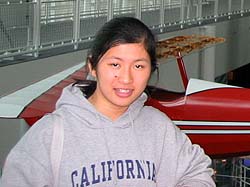- NASA Home
- | For Educators
- | Grades 9-12
- | Featured Materials
Feature
Who are NASA's Earth Explorers?
10.16.03
The Thacher Scholarship - awarded annually to an exceptional high school student displaying the best use of satellite remote sensing in understanding our changing planet - is inspiring a new generation of young explorers.
Winners are chosen from the first-place finishers in the NASA Student Involvement Program's (NSIP) Watching Earth Change competition, which offers students an opportunity to explore how Earth is changing using NASA science and technology.
Thacher Scholarship Winners: Where Are They Now? - The $4,000 award was founded by the Institute for Global Environmental Strategies (IGES) in honor of the late Peter S. Thacher, an internationally recognized leader in promoting the use of satellite remote sensing and former United Nations assistant secretary-general.
 |
The Winner of the 2003 Thacher Scholarship
|
William Werbel (2002)
After winning last year's Thacher Scholarship as a sophomore at Horace Greeley High School in Chappaqua, New York, William Werbel is well on his way to a career in science.
During this past summer, Werbel worked at Columbia University on a research project focused on biomedical engineering, and also attended a two-week chemistry program run by Ciba Specialty Chemicals.
NSIP and the Thacher Scholarship "reinforced my interest in science research and my confidence in my ability to pursue and succeed in a science-related career," Werbel said.
Werbel conducted the research for his NSIP paper, Chernobyl: A Disaster?, as part of his high school's science research program, which he will complete during the coming school year. Now a senior and armed with an SAT score of 1600, Werbel said he would like to attend a college that offers majors in biochemistry and premed.
Yuliya Kuznetsova (2001)
It was a little more than four years ago that Yuliya Kuznetsova, barely able to speak English, arrived in the United States from Tomsk, Siberia. Today, she's thinking about a career in quantum physics as she begins her freshman year at the California Institute of Technology (Caltech).
"It is difficult to put into words how much NSIP and winning the Thacher Scholarship affected my life," Kuznetsova said. "[The program] helped me realize how much I can achieve and inspired me to pursue a career in science."
Kuznetsova earned the Thacher award with her paper, The Recession of Glaciers Due to an Increase in the Emission of Greenhouse Gases in the Atmosphere, a topic she picked because of her concern about global warming.
"Now that I look back at winning. . . I realize that if it had never happened, I would have probably stayed in-state for college and not made any of those huge, great plans about becoming a scientist."
Julia Greenberg (2000)
Julia Greenberg, who won the first annual Thacher Scholarship as a freshman at Evanston Township High School in Evanston, Illinois, is a freshman once again - this time at Columbia University.
Greenberg has recently started in the school's newly established Department of Ecology, Evolution and Environmental Biology. The undergraduate program is affiliated with the Center for Environmental Research and Conservation (CERC), where Greenberg previously applied her scholarship toward a summer course in conservation biology.
"It was this experience that introduced me to CERC's undergraduate program and fueled my interest in Columbia," Greenberg said.
The program's interdisciplinary curriculum will allow Greenberg to further investigate conservation issues, such as the ones dealt with in her paper, The Die-Off of Mangrove Trees in the Saloum River, which merited her the Thacher award.
"My experience with NSIP is undoubtedly connected to where I am today," Greenberg said.
For more information about NSIP, including how to enter the competition for this school year, please visit:
http://education.nasa.gov/nsip
Coming in November, Earth Explorers celebrates Native American month with a look at how Native Americans are using NASA satellite imagery to improve their quality of life and promote Earth science education.